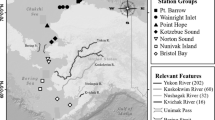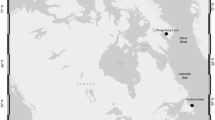Abstract
Capelin is a planktivorous key fish species in many subarctic ecosystems representing the link between lower trophic levels and apex predators. Little is known, however, of capelin in Greenland waters, but it has been suggested that size and growth increases due to difference in food availability and temperature conditions along a 1,500 km south–north gradient on the west coast. It is presently unknown how the qualitative state of capelin energy content is affected along this gradient. Based on 2007 and 2008 samples, we show that energy content increases with capelin length in both spawning and non-spawning fish and that it varies with latitude in spawning fish along West Greenland (60–71°N). Combining our results on energy content with information on capelin growth along the same latitudinal climate gradient demonstrates that less and lower-quality food is available to capelin predators in the south than in the north.







Similar content being viewed by others
References
Angantyr LA, Kapel FO (1990). Harp seal feeding habits in Greenland—our present knowledge, April 1990. Technical Report of the Greenland Fisheries Research Institute, p 72
Anonymous (2005) Arctic climate impact assessment. Cambridge University Press, Cambridge
Anthony JA, Roby DD, Turco KR (2000) Lipid content and energy density of forage fishes from the northern Gulf of Alaska. J Exp Mar Biol Ecol 248:53–78
Bakun A (2006) Wasp-waist populations and marine ecosystem dynamics: navigating the “predator pit” topographies. Prog Oceanogr 68:271–288
Ball JR, Esler D, Schmutz JA (2007) Proximate composition, energetic value, and relative abundance of prey fish from the inshore eastern Bering Sea: implications for piscivorous predators. Pol Bio 30:699–708
Behrens JW, Præbel K, Steffensen JF (2006) Swimming energetics of the Barents Sea capelin (Mallotus villosus) during the spawning migration period. J Exp Mar Biol Ecol 331:208–216
Carr JP, Kaufman L (2009) Estimating the importance of maternal age, size, and spawning experience to recruitment of Atlantic cod (Gadus morhua). Bio Cons 142:477–487
Carscadden JE, Frank KT, Leggett WC (2001) Ecosystem changes and the effects on capelin (Mallotus villosus), a major forage species. Can J Fish Aquat Sci 58:73–85
Christiansen JS, Præbel K, Siikavuopio SI, Carscadden JE (2008) Facultative semelparity in capelin Mallotus villosus (Osmeridae)—an experimental test of a life history phenomenon in a sub-arctic fish. J Exp Mar Biol Ecol 360:47–55
Craig JF, Kenley MJ, Talling JF (1978) Comparative estimations of the energy content of fish tissue from bomb calorimetry, wet oxidation and proximate analysis. Fresh Bio 8:585–590
Cury P, Bakun A, Crawford RJM, Jarre A, Quinones RA, Shannon LJ, Verheye HM (2000) Small pelagics in upwelling systems: patterns of interaction and structural changes in “wasp-waist” ecosystems. ICES J Mar Sci 57:603–618
Drinkwater KF (2005) The response of Atlantic cod (Gadus morhua) to future climate change. ICES J Mar Sci 62:1327–1337
Eaton CA, Ackman RG, Tocher CS, Spencer KD (1975) Canadian Capelin 1972–1973—fat and moisture composition, and fatty-acids of some oils and lipid extract triglycerides. J Fish Res Board Can 32:507–513
Falk K, Durinck J (1993) The winter diet of thick-billed murres, Uria Lomvia, in Western Greenland, 1988–1989. Can J Zool 71:264–272
Fiksen O, Giske J, Slagstad D (1995) A spatially explicit fitness based model of capelin migrations, the Barents Sea. Fish Oceanogr 4:193–208
Finstad AG, Berg OK, Langeland A, Lohrmann A (2002) Reproductive investment and energy allocation in an alpine Arctic charr, Salvelinus alpinus, population. Environ Biol Fishes 65:63–70
Frank KT, Carscadden JE (1989) Factors Affecting Recruitment Variability of Capelin (Mallotus villosus) in the Northwest Atlantic. ICES J Mar Sci 45:146–164
Friis-Rødel E, Kanneworff P (2002) A review of capelin (Mallotus villosus) in Greenland waters. ICES J Mar Sci 59:890–896
Gjøsæter H (1998) The population biology and exploitation of capelin (Mallotus villosus) in the Barents Sea. Sarsia 83:453–496
Gjøsæter H, Loeng H (1987) Growth of the Barents Sea Capelin, Mallotus Villosus, in Relation to Climate. Environ Biol Fishes 20:293–300
Gjøsæter J, Monstad T (1973) Fecundity and egg size of spring spawning Barents sea capelin. FiskDir Skr (Ser Havunders) 16:98–104
Gjøsæter H, Dalpadado P, Hassel A (2002) Growth of Barents Sea capelin (Mallotus villosus) in relation to zooplankton abundance. ICES J Mar Sci 59:959–967
Glebe BD, Leggett WC (1981) Temporal, intra-population differences in energy allocation and use by American Shad (Alosa sapidissima) during the spawning migration. Can J Fish Aquat Sci 38:795–805
Hedeholm R, Grønkjær P, Rysgaard S (submitted) Feeding ecology of capelin (Mallotus villous Müller) in West Greenlandic waters. Pol Bio
Hedeholm R, Grønkjær P, Rysgaard S (2010) Differentiated growth of Greenlandic capelin (Mallotus villosus Müller) along a latitudinal gradient. ICES J Mar Sci 67:1128–1137
Hislop JRG, Harris MP, Smith JGM (1991) Variation in the calorific value and total energy content of the lesser Sandeel (Ammodytes marinus) and other fish preyed on by seabirds. J Zool 224:501–517
Holland MM, Bitz CM (2003) Polar amplification of climate change in coupled models. Clim Dyn 21:221–232
Huse G (1998) Sex-specific life history strategies in capelin (Mallotus villosus)? Can J Fish Aquat Sci 55:631–638
Huse G, Ellingsen I (2008) Capelin migrations and climate change—a modelling analysis. Clim Change 87:177–197
Huse G, Gjøsæter H (1997) Fecundity of the Barents Sea capelin (Mallotus villosus). Mar Biol 130:309–313
Jangaard PM (1974) The capelin (Mallotus villosus). Biology, distribution, exploitation, utilization and composition. Fish Res Bd Can Bull 186:1–70
Jensen AS (1939) Concerning a change of climate during recent decades in the Arctic and Subarctic regions, from Greenland in the west to Eurasia in the east, and contemporary biological and physical changes. Det. Kgl. Danske Videnskabernes Selskab Biologiske Medd 14:1–77
Jezierska B (1974) The effect of various type of food on the growth and chemical composition of the body of perch (Perca fluviatilis L.) in laboratory conditions. Pol Arch Hydrobiol 21:467–479
Jonsson N, Jonsson B (1997) Energy allocation in polymorphic brown trout. Func Ecol 11:310–317
Jordan F, Liu WC, Wyatt T (2005) Topological constraints on the dynamics of wasp-waist ecosystems. J Mar Syst 57:250–263
Karamushko LI, Christiansen JS (2002) Aerobic scaling and resting metabolism in oviferous and post-spawning Barents Sea capelin Mallotus villosus villosus (Müller, 1776). J Exp Mar Biol Ecol 269:1–8
Kitts DD, Huynh MD, Hu C, Trites AW (2004) Season variation in nutrient composition of Alaskan walleye pollock. Can J Zool/Rev Can Zool 82:1408–1415
Lavigne DM, Innes S, Stewart REA, Worthy GAJ (1985) An annual energy budget for north-west Atlantic harp seals. In: Marine mammals and fisheries, 319–335
Lawson JW, Magalhaes AM, Miller EH (1998) Important prey species of marine vertebrate predators in the northwest Atlantic: proximate composition and energy density. Mar Ecol Prog Ser 164:13–20
Madsen SD, Nielsen TG, Hansen BW (2008) Annual population development and production by small copepods in Disko Bay, western Greenland. Mar Biol 155:63–77
Montevecchi WA, Piatt J (1984) Composition and energy contents of mature inshore Spawning Capelin (Mallotus villosus)—implications for seabird predators. Comp Biochem Physiol A: Mol Integr Physiol 78:15–20
Nakashima BS (1987) Regional and temporal variations in fecundity of capelin in Newfoundland waters. T Am Fish Soc 116:864–873
Neve PB (2000) The diet of the minke whale in Greenland—a short review. Minke Whales, Harp and Hooded Seals: Major Predators in the North Atlantic Ecosystem. NAMMCO Scientific Publications 2:92–96
Nielsen JR, Andersen M (2001) Feeding habits and density patterns of Greenland cod (Gadus ogac) (Richardson 1836), at West Greenland compared to those of the coexisting Atlantic cod, Gadus morhua L. J Northwest Atl Fish Sci 29:1–22
O’Driscoll RL, Parsons MJD, Rose GA (2001) Feeding of capelin (Mallotus villosus) in Newfoundland waters. Sarsia 86:165–176
Phillips RA, Petersen MK, Lilliendahl K, Solmundsson J, Hamer KC, Camphuysen CJ, Zonfrillo B (1999) Diet of the northern fulmar Fulmarus glacialis: reliance on commercial fisheries? Mar Biol 135:159–170
Præbel K, Westgaard JI, Fevolden SE, Christiansen JS (2008) Circumpolar genetic population structure of capelin Mallotus villosus. Mar Ecol Prog Ser 260:189–199
Rice J (1995) Food web theory, marine food webs, and what climate change may do to northern marine fish populations. In: Beamish RJ (ed) Climate change & Northern fish populations. Canadian special Publications of Fisheries and Aquatic Sciences, vol 121, pp 561–568
Romano MD, Piatt JF, Roby DD (2006) Testing the junk-food hypothesis on marine birds: effects of prey type on growth and development. Waterbirds 29(4):407–414
Rose GA, O’Driscoll RL (2002) Capelin are good for cod: can the northern stock rebuild without them? ICES J Mar Sci 59:1018–1026
Schwartzlose RA et al (1999) Worldwide large-scale fluctuations of sardine and anchovy populations. S Afr J Mar Sci-S-Afr Tydskr Seewe 21:289–347
Schwarz G, Hammer C (1996) Size and seasonal effects on the body calorific content of North Sea whiting (Merlangius merlangus L, Gadidae). Arch Fish Mar Res 44:33–46
Smith RL, Paul AJ, Paul JM (1990) Seasonal-changes in energy and the energy-cost of spawning in Gulf of Alaska Pacific Cod. J Fish Biol 36:307–316
Sørensen EF (1985) Ammassat ved Vestgrønland [Capelin at West Greenland], Fiskeri- og Miljøundersøgelser i Grønland
Sørensen EF, Simonsen V (1988) Genetic differentiation among populations of Capelin Mallotus villosus from the West-Coast of Greenland. J Appl Ichthyol/Z Angew Ichtyol 4:23–28
Templeman W (1948) The life history of the capelin (Mallotus villosus O. F. Müller) in Newfoundland waters. Research Bulletin of the Newfoundland Government Laboratory 17:151
Trippel EA (1998) Egg size and viability and seasonal offspring production of young Atlantic cod. T Am Fish Soc 127:339–359
Van Pelt TI, Piatt JF, Lance BK, Roby DD (1997) Proximate composition and energy density of some North Pacific forage fishes. Comp Biochem Physiol A: Mol Integr Physiol 118:1393–1398
Velikanov AY (2002) Spatial differences in reproduction of capelin (Mallotus villosus socialis) in the coastal waters of Sakhalin. ICES J Mar Sci 59:1011–1017
Vilhjalmsson H (2002) Capelin (Mallotus villosus) in the Iceland-East Greenland-Jan Mayen ecosystem. ICES J Mar Sci 59:870–883
Vilhjálmsson H (1994) The Icelandic Capelin Stock. J Marine Res Inst (281 pp)
Winters GH (1971) Fecundity of left and right ovaries of Grand Bank Capelin (Mallotus villosus). J Fish Res Board Can 28:1029–1033
Woll AK, Gundersen AC (2004) Diet composition and intra-specific competition of young Greenland halibut around southern Greenland. J Sea Reas 51:243–249
Acknowledgments
We thank the staff at the Greenland Institute of Natural Resources for help with sampling. Additionally, we thank two anonymous reviewers for helpful comments on an earlier version of the manuscript.
Author information
Authors and Affiliations
Corresponding author
Additional information
Communicated by C. Harrod.
Rights and permissions
About this article
Cite this article
Hedeholm, R., Grønkjær, P. & Rysgaard, S. Energy content and fecundity of capelin (Mallotus villosus) along a 1,500-km latitudinal gradient. Mar Biol 158, 1319–1330 (2011). https://doi.org/10.1007/s00227-011-1651-5
Received:
Accepted:
Published:
Issue Date:
DOI: https://doi.org/10.1007/s00227-011-1651-5




